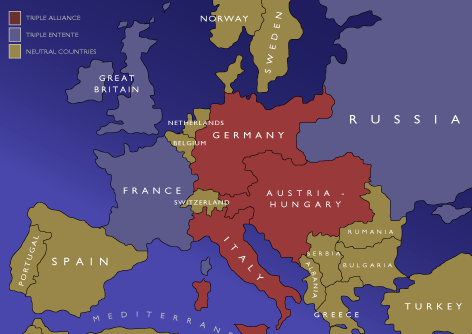
How can the ideas of the simulation be used by you?
The following 3 steps will help you create your own simulations within a "Big Picture" simulation.
take away.
step 2: the Smaller Simulation(s)
A simulation is most effective when there are:
-
Specific transferable Learnings or Skills are targeted and are reflected upon at the end
-
The act of participation reflects the learnings and / or skills and / or learning standards
In this demonstration we show how to create a simulation similar to one we use when examining World War 1.
Note: During the conference we ran this simulation - see the images for the final result!









Part 1: Transferable Skills and Learnings
Ideally this is the act of participation in the simulation.
Transferable Skills: Negotiation and Point of View
Transferable Learning: Alliances between nations provide a sense of security while at the same time may appear threatening to others

Part 3: Learning Standards
The corresponding learning standards for this specific learning.
Learning Standards: NCSS Standard 9
-
Learners will understand conflict and cooperation among the peoples of the earth influence the division and control of the earth's surface.
-
Learners will understand the causes and consequences of various types of global connections.
-
Learners will be able to describe and explain conditions and motivations that contribute to conflict, cooperation, and interdependence among groups, societies and nations

Part 4: The Simulation Instructions
This is how you "play" the simulation.
Description: In this simulation each group of students for a specific colour representing a country. The goal is to create alliances with other countries.
Requirements: In order to create a reason to form alliances, groups need context. In this case each group has resources someone else wants. Some groups are geographically well placed while some are more open to attack. Some groups are militarily weak while others a strong. This simulates the context of WW1. Statistics and maps need to be created beforehand.
Phase 1 - Analysis - Your Country
Players on each team should first examine their own country.
-
Where is your country on the map?
-
How many provinces are there?
-
What resources do they have?
-
The higher income, the better.
-
Are their people happy? If so, they have enough food. If not, they need more food.
-
Do they have coal? Coal can be used to trade for food or create more income (through factories)
-
-
How many soldiers do they have and where are they placed?
Phase 2 - Analysis - Other Countries
Who is around you? What do they have of the above resources?
-
Do they have something you need or do you have something they need?
-
Do they look threatening?
-
Could they provide you with security?
-
Would they be someone you would consider necessary to get on side?
Phase 3 - Action - Negotiate Alliances
Now you must try and create agreements. The goal is to create alliances in order of priority:
-
Provide defensive security acting as a deterrent
-
Permit trade for resources you need
-
Provide offensive security in the event of war and will ensure you are safe while you expand
Part 5: Post Simulation Reflection
Having completed the simulation, link to the standards by reflecting on the learnings and skills.
Possible Reflection Questions
-
What motivations did you consider when seeking out an alliance?
-
Explain the process of creating a successfully negotiated alliance.
-
Describe what you offered and were offered by others in order to create an agreement.
-
Having created your alliance, what actions did others take in response?
-
Why did they do this? What impact do you think your alliance have on their thinking?
-
How did you view these opposing alliances? What impact did they have on your thinking?
-
How do you think alliances contributed to the onset of WW1?




